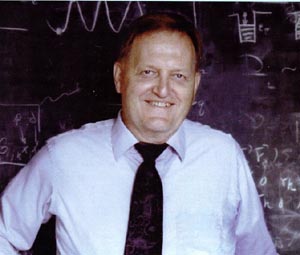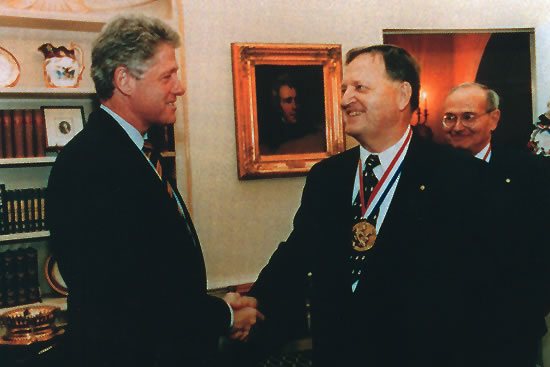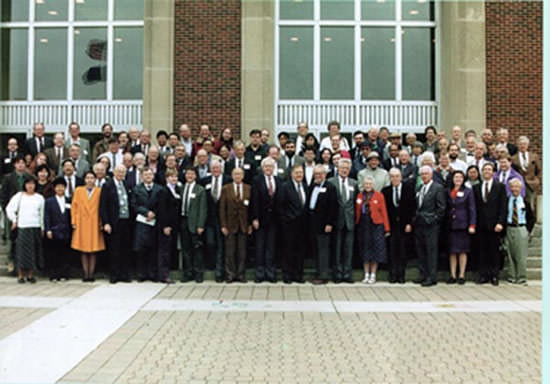Albert W. Overhauser
by Solomon Gartenahaus

Albert W. Overhauser (1925-2011) - Obituary
I. Biographical
On 19 December 1994, Professor Albert Overhauser was invited to a reception in the Oval Office of the White House, where President Bill Clinton personally congratulated him on being awarded the National Medal of Science; the highest honor the United States bestows on its citizens for scientific achievement. He thus joined an elite group of two---the other member being the Nobel Laureate Herbert C. Brown---who in Purdue's 120-year history have been awarded this prestigious medal. The citation reads in part:
"For his fundamental contributions to understanding the physics of solids, to theoretical physics and for the impact of his technological advances..."The National Medal of Science is, perhaps, the most coveted of the many awards that Overhauser received during his 50 year long career, in recognition of his many seminal contributions to physics.
Overhauser was born on 17 August 1925 in San Diego, California to Clarence Albert Overhauser and Gertrude Irene Pehrson. The family including his sister Evaclaire Overhauser (Gatto) moved to San Francisco in 1935 where Al attended high school. He had the good fortune to attend Lick Wilmerding high school and to have as his high school physics teacher the very inspirational Ralph Britton. The latter convinced him to give up his aspirations to become a civil engineer and instead to study physics. Many years later Al found out that Ralph Britton was also instrumental in convincing another eminent condensed matter physicist, Frederick Seitz, to become a physicist.
Following high school graduation, Al attended the University of California, Berkeley (1942-44) and then did a brief stint (1944-46) in the U.S. Naval Reserve, during World War II. There he trained in electronics as a radar repair specialist, an experience he always felt was very valuable to him as a scientist. In 1946 he resumed his education at the University of California, Berkeley where in 1948 he received the BA, Magna Cum Laude in Physics and in Mathematics. He stayed on at Berkeley and in 1951 was awarded the Ph.D. in Physics for research carried out under the supervision of Charles Kittel.
He began his professional career as a "post-doc" at the University of Illinois during 1951-53. It was during this very early period that he developed his famous theory of dynamic nuclear polarization which shortly after its experimental confirmation became known by its current name, the Overhauser effect. In 1953 he went to Cornell as an Assistant Professor, and was promoted to Associate Professor three years later. He left Cornell in 1958 to accept a position on the Scientific Research Staff of the Ford Motor Co. in Dearborn, Michigan and was rapidly promoted there becoming: Manager, Mathematical and Theoretical Sciences in 1962; Assistant Director, Physical Science Laboratory in 1969; and ultimately Director of the Physical Sciences Laboratory in 1972. He left Ford in 1973 to become Professor of Physics at Purdue University. The following year he was named the Stuart Distinguished Professor of Physics, a position he has held continuously to this day.

Al Overhauser (here with President Clinton and the President Emeritus of the National Academy of Sciences Frank Press) was a recipient of the 1994 National Medal of Science.
He married Margaret Mary Casey on 25 August 1951. They have eight children who in order of decreasing age, are: Teresa, Catherine, Joan, Paul, John, David, Susan and Steven.
During his long career, Overhauser has presented, on the average, a dozen or so lectures, seminars or colloquia at a variety of institutions annually. In addition he has delivered about 150 APS and other short talks. His invitations to give lectures have come from among the most prestigious universities and research institutes both in the United States and abroad. Foreign countries where he has been invited to lecture include: Belgium, Canada, Denmark, France, Germany, Great Britain, Ireland, Italy, Japan, the Netherlands, Portugal, Mexico, Sweden, Switzerland and Venezuela. To most of these he has been invited several times.
As might be expected, besides his being awarded the National Medal of Science in 1994, he has received numerous other distinguished honors. He was awarded the Honorary Doctor of Laws degree from Simon Fraser University (Canada) in 1998, and the Honorary Doctor of Science from the University of Chicago---which awards at most only one D.Sc. degree each year---in 1979. He received the Alexander von Humboldt Senior Scientist Award in 1979-80. He became the Stuart Distinguished Professor of Physics at Purdue in 1974 and was awarded the Herbert N. McCoy Research Award at Purdue in 1978. In April 1975 he received the very prestigious Oliver E. Buckley Solid State Physics Prize:
"...awarded by the American Physical Society to a person who has been adjudged to have made a most important contribution to the advancement of knowledge in Solid State Physics"He is the only person from the Purdue Department of Physics, in all its history, to be elected to membership in the National Academy of Sciences (1976). He is a Fellow of the American Academy of Arts and Sciences, and was a Visiting Scientist of the Japan Society for the Promotion of Science in 1978. In addition he has been invited to---and served on---a number of distinguished panels and boards including: the Buckley Prize Committee (chair 1989, 1990); Board of Trustees, Argonne Universities Association; NSF Solid State Review Panel for Harvard, Cornell, Northwestern, Brown and the National Magnet Laboratory; and has been Counselor-at-Large of the American Physical Society, 1982-86.

The participants in the Albert W. Overhauser Symposium at Purdue University, 21 October 1995.
In a glorious tribute to Al Overhauser, on 21 October 1995, the Albert W. Overhauser Symposium took place on the campus of Purdue University. On this occasion relatives, friends, former students, post-docs and representatives of the entire condensed matter community came to honor and to pay tribute to him on the occasion of his seventieth birthday. Among the professional colleagues in attendance and presenting papers were: Anthony Arrot, Morrel Cohen, Gene Dresselhaus, Mildred Dresselhaus, Helmut Fritsche, John Quinn, Frederick Seitz, Charles Slichter, Valentino Telegdi and Samuel Werner. It was a truly fitting and moving honor for a person who has devoted two thirds of his life to research and to enrich condensed matter physics. Under his leadership several new avenues of research with lasting impact on science and technology have been opened.
II. Dynamic Nuclear PolarizationIt is certainly reasonable to suppose that Overhauser's most important contribution to science will be judged to be his concept of---and work on---dynamic nuclear polarization. As the citation when he received an honorary degree at the University of Chicago reads:
"Overhauser proposed ideas of startling originality, so unusual that they initially took portions of the scientific community back, but of such depth and significance that they opened vast new areas of science."The consequences of this discovery---known as the Overhauser Effect---for nuclear magnetic resonance, and through nuclear magnetic resonance for chemistry, biology and high-energy physics have been enormous. The idea, which has also had very practical consequences, was so unexpected that it was originally resisted vehemently by the authorities in the field. Not until its existence was demonstrated experimentally by Slichter and Carver(1)in 1953 was it fully accepted. It has been said that one can judge the importance of a new discovery in physics by the number of other fields of science and engineering it impacts. From this point of view this contribution of Overhauser ranks among the highest.
In simplest terms, Overhauser was the first to demonstrate that it is possible to line-up, or to polarize, nuclear spins by a factor 1000 or so larger than one would expect based on then common intuitive notions. The trick that he used was first to impose microwave power on the nuclear-electron system and thereby excite the electronic spins to higher, non-thermal equilibrium states. Then because of the coupling between the electron and the nuclear spins, as the excited electron spins try to equilibrate to their lower states they reorient the nuclear spins. The nuclear spins then exhibit an enhanced polarization by a factor equal to the ratio of the electronic to the nuclear magnetic moments i.e., by about a factor of ≅ 1000.
When first proposed as a contributed paper at an APS meeting in April 1953, the proposal was met with much skepticism by a formidable array of physics talent. Included among these were notables such as: Felix Bloch (recipient of 1952 Physics Nobel Prize), Edward M. Purcell (recipient of Nobel Prize 1952 with Bloch and session chair), Isidor I. Rabi (recipient of Physics Nobel Prize, 1944) and Norman F. Ramsey (recipient of Physics Nobel Prize, 1989). Eventually everyone was won over. In a letter dated 27 July 1953, Norman F. Ramsey stated the matter succinctly2,3:
July 27, 1953
Dear Dr. Overhauser:
You may recall that at the Washington Meeting of the Physical Society, when you presented your paper on nuclear alignment, Bloch, Rabi, Pearsall, and myself all said that we found it difficult to believe your conclusions and suspected that some fundamental fallacy would turn up in your argument. Subsequent to my coming to Brookhaven from Harvard for the summer, I have had occasion to see the manuscript of your paper.
After considerable effort in trying to find the fallacy in your argument, I finally concluded that there was no fundamental fallacy to be found. Indeed, my feeling is that this provides a most intriguing and interesting technique for aligning nuclei. After considerable argument, I also succeeded in convincing Rabi and Bob Pound of the validity of your proposal and I have recently been told by Pound that he subsequently converted Pearsall shortly before Pound left for Europe.
I hope that you will have complete success in overcoming the rather formidable experimental problems that still remain. I shall be very interested to hear of what success you have with the method.
Sincerely,
Norman F. Ramsey
Some forty years later, Overhauser sent a copy of this letter to Ramsey as a remembrance of the encouragement he had earlier provided to a very green, newly minted Ph.D. Ramsey's reply shed more light on the subsequent acceptance of the Overhauser effect:
April 20, 1993
Dear Al:
I greatly appreciate your thoughtful remarks about the letter I wrote you forty years ago. Although I clearly remember surprising some of my friends by writing a very favorable referee report, I had forgotten that I also had written you a letter.
You might be interested in how I came to get the matter straight and avoid the lifelong embarrassment of being responsible for the rejection of a great pioneering paper.
After the APS meeting I did not understand your paper and was thoroughly convinced by the vigorous arguments of Bloch, Rabi and others that a radio frequency field always produces heating. I was consequently annoyed when I was asked to referee the paper and therefore would have to find exactly what was wrong. I started my study with strong prejudices against you but I then remembered that in high school physics I had always had trouble remembering how a Servel (gas) refrigerator worked. I decided that I could not write a negative referee report until I understood once again how the Servel worked. By the time I understood that, I had lost my prejudice against your paper and on further study was convinced you were right. Incidentally the easiest way for me to remember how in principle a gas refrigerator can work without violating thermodynamics is to remember one could use the heat of the gas flame to operate a steam engine which in turn could operate a mechanical refrigerator.
Sincerely yours,
Norman F. Ramsey
Experimental confirmation of the Overhauser Effect was soon available via the experiments of Carver and Slichter(1). As described by Overhauser(2)
The most direct experimental test of dynamic nuclear polarization utilizes double resonance. One must select a static field Bo for which rf excitation of the ESR (Electronic Spin Resonance) and measurement of the NMR (Nuclear Magnetic Resonance) can occur simultaneously. This difficult experiment was first attempted by Carver and Slichter in metallic lithium. They selected Bo = 30.3 G, which required an NMR frequency of only 50 kHz. The ESR frequency was 84 MHz. Without the 84 MHz oscillation, no 7Li NMR signal was visible. However, with B1 = 5 G (for the 84 MHz excitation), a large 7LiNMR resonance appeared. On comparing the signal amplitude to the NMR protons in glycerin (also at 50 kHz), the 7Li NMR enhancement was estimated to be ~ 100.
Since the original discovery and its subsequent confirmation in a wide variety of experiments, the Overhauser effect has been used in Nuclear Magnetic Resonance applications to determine the structure of proteins and other molecules. This pervasive use of the Overhauser effect has spawned a variety of new terms. For example, the "Nuclear Overhauser Effect" (NOE) describes a collection of adaptations of the Overhauser Effect. Some of the techniques employing the effect include:
NOESY - Spectroscopy based on the Nuclear Overhauser Effect;
HOESY - Heterogeneous Nuclear Overhauser Effect Spectroscopy;
ROESY - Rotational Frame Nuclear Overhauser Effect Spectroscopy;
TRNOE -Transferred Nuclear Overhauser Effect.
The Nuclear Overhauser Effect has been called the most powerful tool for determining the structure of complex biological molecules. Research dealing with the Effect has been carried out worldwide at many universities and various research institutions and across a very large variety of disciplines. Some of the disciplines utilizing NOE include chemistry, biomedical science, clinical medicine, macromolecular biology, pharmacology, physics, plant science and structural biology.
Indeed the Effect is so widely exploited by research scientists, that there is almost a tendency to forget that the word "Overhauser" is not an adjective but rather the name of a scientist! A literature search over a four-year period (1989-1993) shows almost 300 journal articles reporting on experiments where the NOE is used to determine the structure of proteins and other molecules of bio-chemical interest. In many of these, the word "Overhauser" appears in the title. In addition there are two monographs that the present author is aware of in which the word "Overhauser" appears in the title. These are: the book(4) by D. Neuhaus and M. Williamson entitled "The Molecular Overhauser Effect In Structural and Conformational Analysis", and the book(5) by J.H. Noggle and R. Schirmer, entitled "The Nuclear Overhauser Effect, Chemical Applications".
But that is not all! Besides its direct usage in scientific research, the Overhauser Effect is also the essential ingredient of an instrument which measures magnetic field strength to very high accuracy. Generically, such devices are known as Overhauser magnetometers. The idea underlying such devices is as follows. When the protons in a material are exposed to a DC magnetic field B, the protons precess with a frequency proportional to B. Thus by measuring the precession frequency and, knowing the coefficient of proportionality to high accuracy, B can be measured. In general this signal is very weak unless the protons are polarized! Thus by using dynamic nuclear polarization, the signal strength can be increased to such an extent that very accurate values for the magnetic field strength can be achieved.
For example, GEM Systems Inc.(6), a scientific instrument manufacturing company, advertises its "GSM-11", as a "High Sensitivity Airborne Proton (Overhauser) Magnetometer" which can measure magnetic field strengths to an accuracy of 10-10 Tesla. Or its "GSM-9BA", Overhauser Proton Magnetometer" with an accuracy ≅ 10-9 Tesla. Or the "Overhauser Scalar Magnetometer developed for measuring the earth's magnetic field from satellites(7). Or the "Overhauser sensors" used to measure terrestrial magnetic fields as developed by the Quantum Magnetometry Laboratory.(8)A truly remarkable tribute.
Although perhaps not as widely known as his discovery of dynamic nuclear polarization Overhauser has a number of other scientific achievements to his credit. These are dispersed among his 180 odd scientific publications.
On being awarded the degree of Honorary Doctor of Laws at Simon Fraser University in 1998, he was recommended in part to the Chancellor of that institution with the following words:
Albert Overhauser's reputation as a brilliantly creative physicist, however, does not rest solely on this [dynamic nuclear polarization] remarkable insight into the nature of the physical world. In 1960 he predicted the existence of spin and charge density waves. This far-reaching concept has led to a deeper understanding of the way electrons behave in metals. And while at Purdue University, Albert Overhauser, together with a colleague [Roberto Colella] constructed a neutron interoferometer, which he then used to show for the first time that gravity plays a role in quantum mechanics. These are but two more examples of the work of a truly penetrating mind.
References
- T.R. Carver and C.P. Slichter, Phys. Rev. 1953, 92 212.
- Albert Overhauser, contained in Encyclopedia of Nuclear Magnetic Resonance, D.M. Grant and R.K. Harris, editors, J. Wiley, New York, 1996, Vol. I p. 513.
- As quoted in reference 2.
- David Neuhaus and Michael P. Williamson, "The Nuclear Overhauser Effect in Structural and Conformational Analysis", V.C.H. Publishers, New York (1989).
- Joseph H. Noggle and Roger Shirmer, "The Nuclear Overhauser Effect, Chemical Applications", Academic Press, New York, 1971.
- GEM Systems, Inc., 52 W. Beaver Creek Rd., Richmond Hill, ON, Canada, L4B.lL9.
- D. Duret et al., Overhauser Magnetometer for the Danish Oersted Satellite, IEEE Transactions on Magnetics Vol. 31, No. 6, November 1995.
- Ural State Technical University, 19 Mira Street, Russia.